Disclaimer
This episode of Colonial Crafts is a demonstration only. The Art and Craft of the Early American Blacksmith involves expertise as it deals with extreme heat and sharp objects.
But don’t worry, you can cast and forge your own works of art with play dough. (Details at the end of this article.)
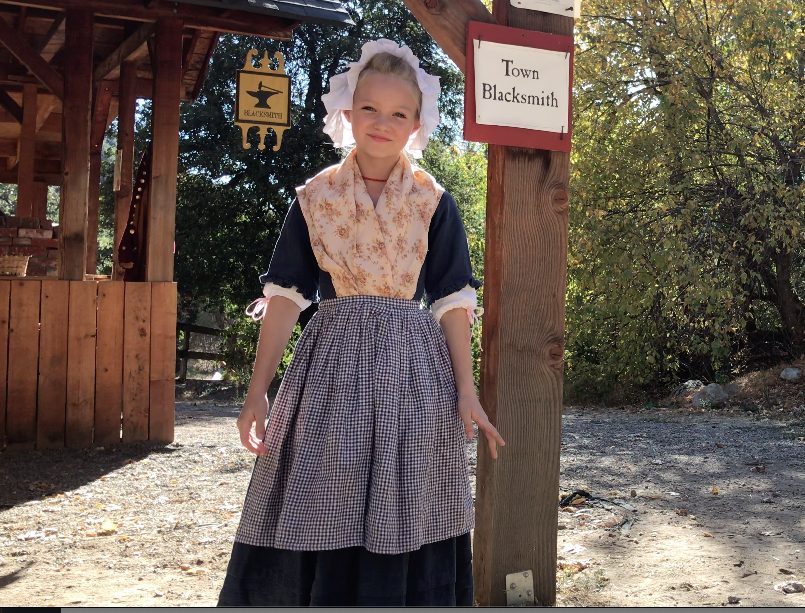
Sage of Colonial Crafts Introduces today’s topic Blacksmithing in Colonial America 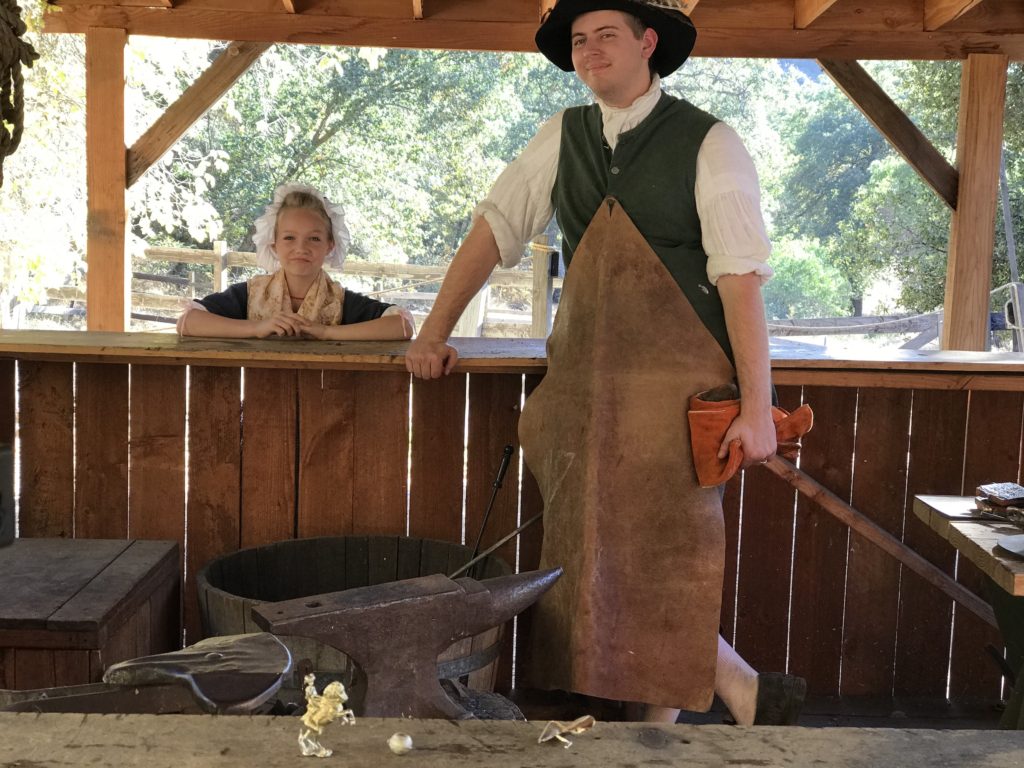
Your host Sage with Kyle, the Blacksmith
Blacksmithing in Colonial America
When most people think of blacksmiths, they picture a sweaty old man with a dirty leather apron leaning over an old anvil pounding out a magical sword or something.
Well it’s not terribly far from how it was. Blacksmith is hard work… it’s hot and sweaty…and dirty…
The Art and Craft of the Early American Blacksmith was essential to life in early America and really was a staple occupation right up until the industrial era when everything got automated with factories.
A blacksmith in colonial America made lots of things, horseshoes, nails, musket balls, and toy soldiers! Basically if it was made of metal, the blacksmith was the guy who made it.
Craft or Necessity
When we see blacksmiths today, we like to watch them make keepsakes to take home or something ornate and pretty but for hundreds of years blacksmiths were super important.
In addition to nails and horseshoes they made pots and pans, farm equipment and more…but most importantly, nails.
Lots and lots of nails…
Video Demonstration
Again, The Art and Craft of the Early American Blacksmith is a demonstration only, not a DIY craft for home.
DIY at home safe version is with play dough and described below.
Training
Learning The Art and Craft of the Early American Blacksmith took a long time. Apprenticeships started young (anywhere from 10-14) and could last up to seven years.
An apprentice would start observing his master before helping with even the easy tasks.
Then the apprentice would learn more complicated tasks like heating and bending iron.
When the master felt the apprentice was ready, he would ask the apprentice to make something that would be judged by his master. If the piece was adequate, the apprentice would pass his apprenticeship and became a journeyman.
A journeyman was essentially a traveling blacksmith who would repair metal goods in nearby villages. At some point the journeyman would earn enough money to open his own shop and then he would become a resident black smith and eventually a master for another apprentice.
You can now sing ‘The Circle of Life’….but with a black smith apron on….
Forging
Forging is the process of shaping of metal using force (typically a hammer or press) and usually heat. In our video Kyle demonstrates foreign by making the thing that was needed the most in colonial times, a simple nail.
Forging produces a stronger and tougher piece of metal. BUT it’s more costly and has some shape limitations.
Casting
Casting is the process of pouring molten metal into a mold. In colonial times it’s how they made musket balls and toy soldiers (as demonstrated in the video).
Casting is able to be used to create large or complex metal components. It would be really tough and take hours to forge a musket ball since it is a sphere and forging doesn’t allow for details like in a toy soldier.
Both processes has their advantages and so were used for different things.
Play Blacksmith at Home
Since it takes years of training and special equipment to learn how to blacksmith, we found a good starter kit. I don’t care how old you are, Play Dough is awesome. It smells awesome. It feels awesome. It’s weirdly therapeutic. Plus who doesn’t want something called a FUN FACTORY?

For something little more firm that can dry and set, try air dry modeling clay.
or
to see The Art and Craft of the Early American Blacksmith in person, visit Colonial Williamsburg, Riley’s Farm, Old Sturbridge where the experts live and work.
Learn More about Blacksmithing
Did this video pique your interest for a new hobby? There are some great books and videos on the market to learn more.
Just know that if you want to really learn the trade, the best thing to do is find a Blacksmith who will teach you about the specialized equipment, old and modern techniques, and how to do them safely. And always always wear protective gear.
Personally, I’m quite content to wear a cute apron and work with play dough.
SO just one more time….THIS IS A DEMO ONLY…NOT a DIY AT HOME CRAFT FOR KIDS.
Do I sound like a broken record yet?
Good. My mom work here is done.
If you are rolling your eyes and repeating it with me then my message has been received.
More Colonial Crafts Tutorials
Sage has a whole series of Colonial Craft Videos for you (not just demonstrations). Check out the whole series here! And keep checking back as we are still filming and adding to this!
or…
Sign Me Up!
Want to get emails that let you know when we post the latest craft video? And other Historical and hysterical adventures and things? Sign up below. Don’t worry, we don’t spam. Just emails from us with useful and fun things like this!
Pin It For Later!
Come back and watch the demo any time! The Art and Craft of the Early American Blacksmith will be here and on the Colonial Craft Playlist on Youtube!
More on Riley’s Farm
We are thrilled to have this partnership with Riley’s Farm in Oak Glen California where we have been able to film several episodes of Colonial Crafts in an authentic setting.
Corn Husk Dolls, Candle Dipping, and The Art and Craft of the Early American Blacksmith!
Riley’s Farm has loads to offer, from one of a kind historical dinner theater to an authentic colonial tavern experience to famous moments recreated like the Boston Massacre and the Patrick Henry speech. They offer a myriad of experiences for individuals and groups alike and we highly recommend you check them out.
Just so I’ve said it one more time, The Art and Craft of the Early American Blacksmith is for demonstration purposes only. This Family Blog seeks to educate and where as most Colonial Crafts are indeed step by step tutorials, this is for education purposes only, not to be tried at home.
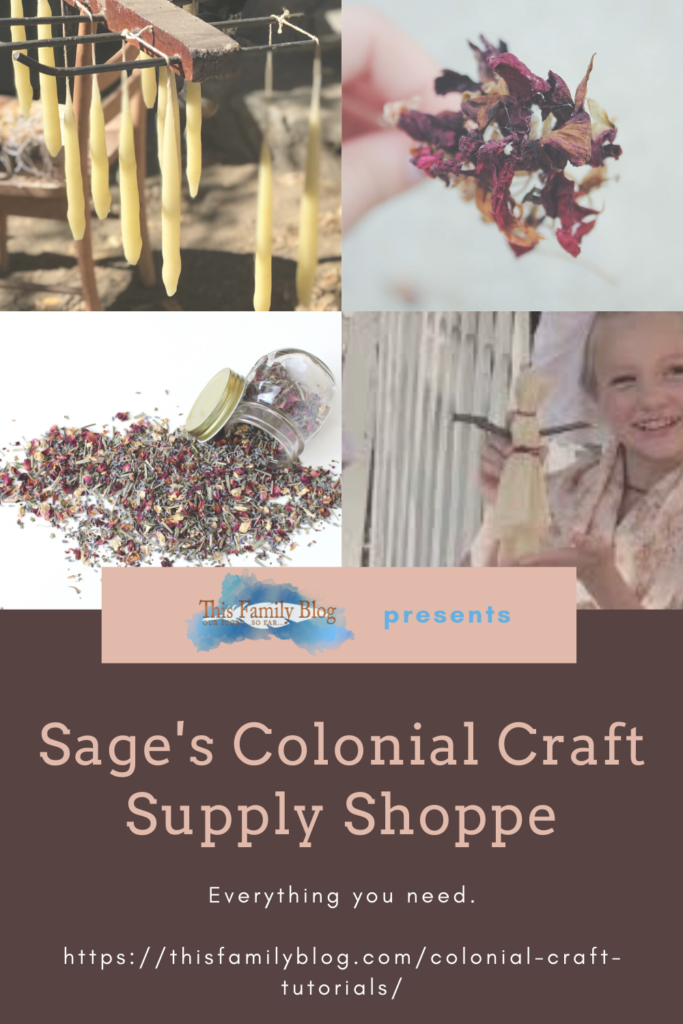

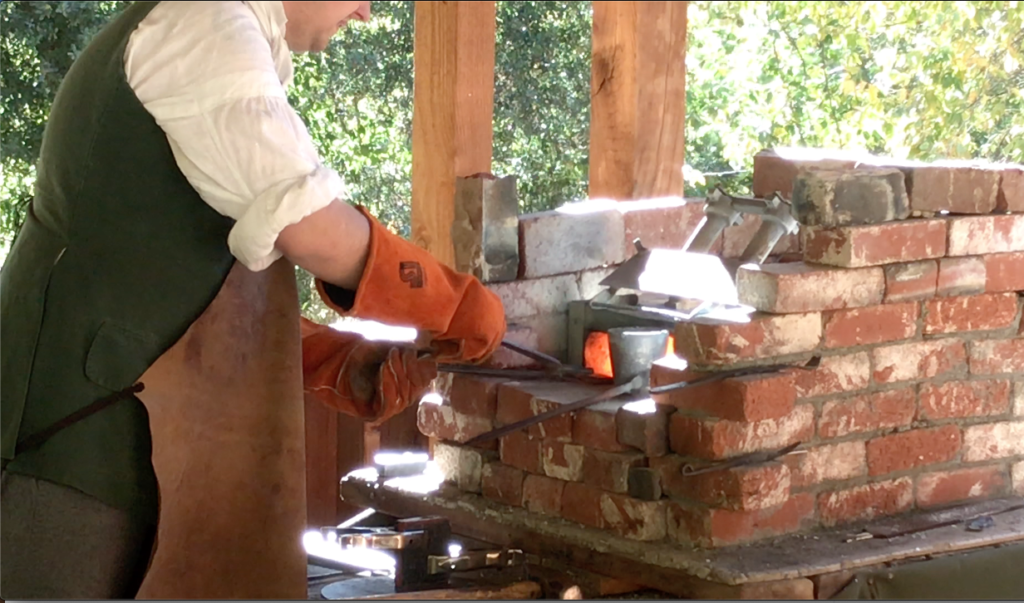
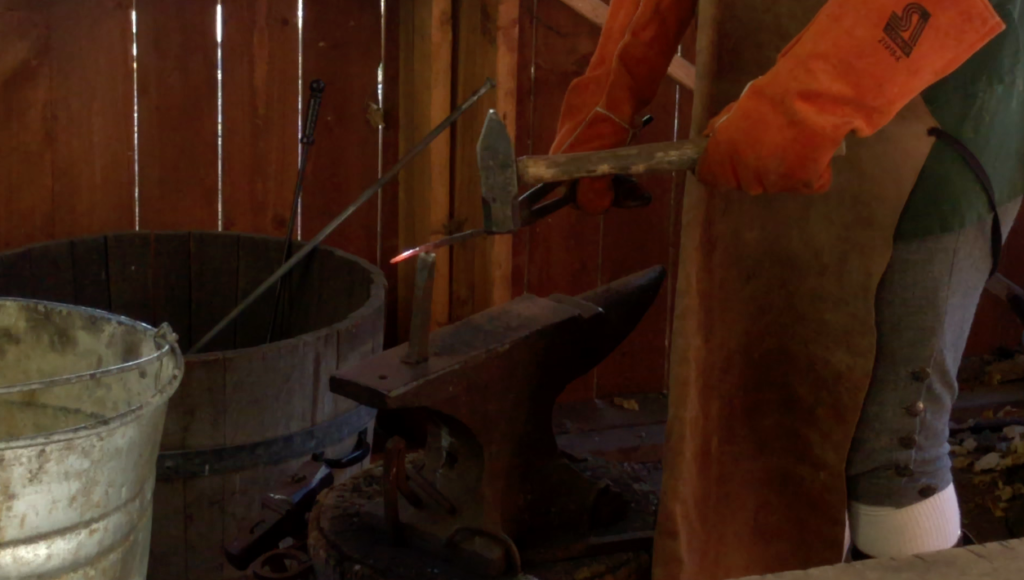
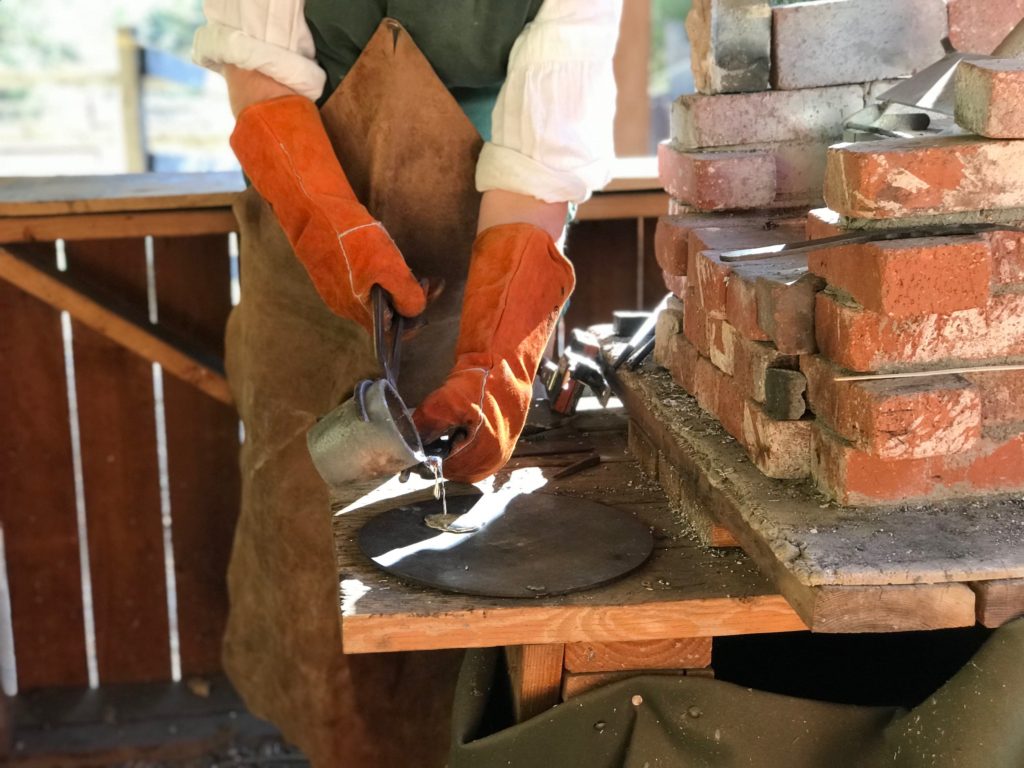


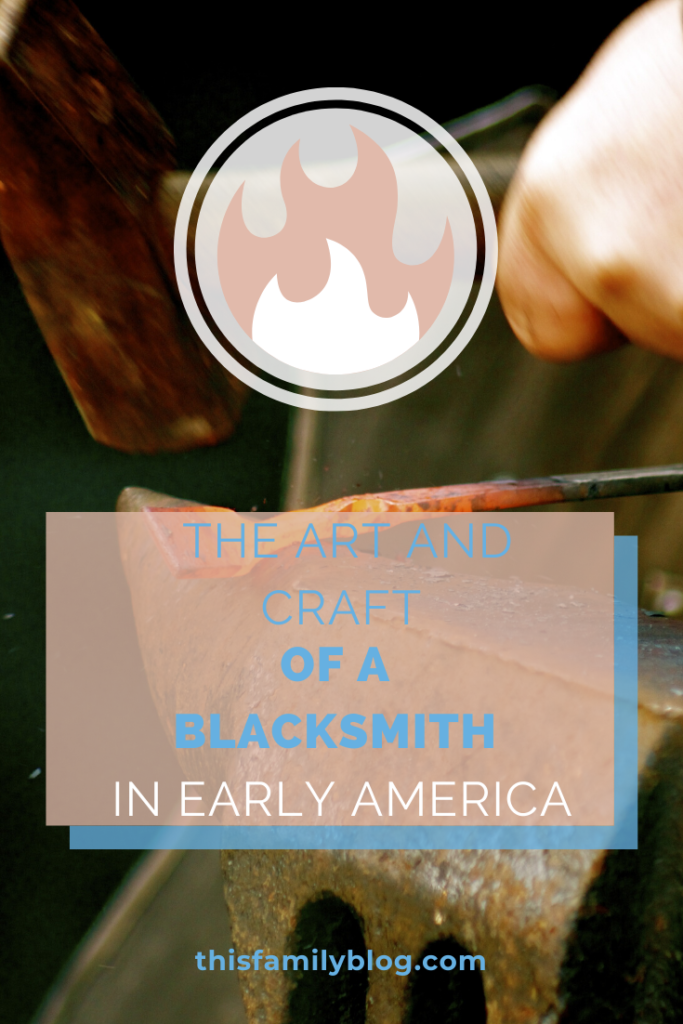



This was an interesting and informative post. I have a picture of my great-grandfather who was a blacksmith.
Your great grandpa was a blacksmith? How cool! You are lucky you have a photo!. Do you have anything from him that he made?
I love this post! I have ancestors who were blacksmiths so this is fascinating.
Thanks for the history lesson! It’s always fascinating to read about how things were done in the past.
This is so informative! Thank you for sharing!
We watched a blacksmith presentation at Mount Vernon and Monticello a couple of years ago. It was very cool to see it in person.
My kid had a field trip last year to a blacksmith and it was a great piece of history and they all enjoyed
Fun post idea. I can just see some 12 year old going to town as a blacksmith, lol
Interesting history!
Yes Colonial America Blacksmith really is! Grubby but fascinating.
I love to see living history. We have a few here in Massachusetts.
I find the craft of the blacksmith in colonial America fascinating. Can’t wait to get to your neck of the woods to check things out.
This was fun to watch and read about!
Thank you for reading and I’m glad you enjoyed the art and craft of the blacksmith in colonial America
We enjoy traveling and seeing living history. It combines my 2 favorite things; traveling and history! This was a very interesting article. Thanks for sharing!
Thank you Cathy! I’m glad you enjoyed the craft of the blacksmith in colonial America. You are our kind of reader so I hope you will consider signing up for our email as well!
Such a cool craft! Loved the video! 🙂
Thank you for watching the craft of the blacksmith in colonial America. I’m glad you enjoyed
I love all things history, so this post was a lot of fun to read. I am so fascinated by blacksmithing (but don’t worry–I won’t try it at home, lol). I once saw a blacksmith in Old World Wisconsin. And Sturbridge Village is one of my favorite places to visit! I’m glad you mentioned it.
I’m so glad you enjoyed the craft of the blacksmith in colonial America! hahahah clearly you read the whole thing! You’re my kind of girl
This is so neat! I remember when I was in elementary school, we went somewhere that showed us what it was like to live in Colonial America. It was impactful enough that I still recall the visit fondly. We even got to make and wear cool little bonnets!
AW that makes me so happy. I have similar memories whether it is the craft of the blacksmith or just life in colonial America . I hope this blog acts as that type of inspiration for others.
That looks like such a fun thing to see and experience! My kids would love to visit here one day and see a blacksmith in action!
Fantastic! In the meantime I hope they enjoy the video of the craft of the blacksmith in colonial America
What an interesting thing to see. We have had horses in the past so I would really enjoy this! Thanks!
It’s grubby and hot but weirdly soothing to be around and there is something about just watching the craft of the blacksmith in colonial America…. the way they pour molten metal… it’s very cool
Great article. I always enjoy watching or hearing about the old crafts.
Thank you Tim. I’m glad you enjoyed the craft of the blacksmith in colonial America. I hope you’ll consider watching some of our other videos.
Loved watching this – but totally not showing my boys cause they will certainly think they can try this.
hahahahah… play dough… or fimo clay. Get the craft of the blacksmith in colonial America without the danger… 😉
What a fun post. Thanks for sharing. One of the main reasons that we travel as a family is to get to see history come to life. Your post does that without having to leave my house – bonus! My 11-year-old went to Colonial Williamsburg with his grandparents last year and one of his favorite parts was getting to see the blacksmith.
Sweet! I’m so glad he likes the craft of the blacksmith in colonial America. I hope he will watch our other crafting videos too!
I love watching people do this type of crafting. It’s so fascinating to see and it’s so rare to have the opportunity to just sit and watch it be done.
Indeed! I often wonder if new people don’t take up the craft of the blacksmith in colonial America what will happen in a generation or two…
Living history is so much fun. This looks like a great experience.
Thank you! It really is…. the craft of the blacksmith in colonial America is just fascinating. I’d love to take a class in it
This is so great to learn how things used to be done. We love all things history so this was a great read!
Glad you enjoyed the craft of the blacksmith in colonial America. I hope you’ll consider signing up for our email. You seem to be the kid of reader that will love our articles.
How cool! It’d be interesting to watch them work.
The craft of the blacksmith in colonial America is fascinating to watch….
I’m interested in blacksmiths. As, it seems my great-great grandfather was one.
OH how cool! I’m absolutely fascinated with the craft of the blacksmith in colonial America. I’m so glad this meant something to you!
Blacksmithing is really an interesting craft and trade.
I find the craft of the blacksmith in colonial America super interesting and becoming a lost art… hence the article. Hoping to inspire someone 🙂
This is such a great experience! I think it is cool to learn how things were done in the past!
I’m betting you have a master in the craft of the blacksmith in colonial America up in your neck of the woods too…. worth going to watch and see.
I love watching a blacksmith at work! We have a couple of festivals in our area where they demonstrate this craft and I could sit and watch them for hours (much to the dismay of my husband who is ready to go after 30 minutes!).
hahahaha yes the craft of the blacksmith in colonial America is weirdly soothing to watch isn’t it?